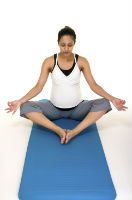Kegels
Kegel exercises help strengthen and tone the pelvic floor in preparation for later in the pregnancy and childbirth. These muscles, whose purpose is to avoid defecation and urination, are stretched to their limits during childbirth. Performing exercises during pregnancy and after childbirth can help with urinary incontinence that can sometimes occur.
The Benefits of Kegel Exercises for Pregnancy and Labor
 The benefits of Kegel exercises are that they strengthen all the muscles supporting your uro-genital tract. Nature intends the pelvic floor muscles to relax somewhat during pregnancy to prepare for delivery of the baby. But if your pelvic floor is already weak you may find you have trouble with leaking of urine as your uterus grows and strains the muscles that support it and your bladder. Incontinence can continue after pregnancy since these muscles are stretched to their utmost when you push out the baby.
The benefits of Kegel exercises are that they strengthen all the muscles supporting your uro-genital tract. Nature intends the pelvic floor muscles to relax somewhat during pregnancy to prepare for delivery of the baby. But if your pelvic floor is already weak you may find you have trouble with leaking of urine as your uterus grows and strains the muscles that support it and your bladder. Incontinence can continue after pregnancy since these muscles are stretched to their utmost when you push out the baby.
Make Birth Easier
Kegel exercises can not only prevent or treat pregnancy incontinence, they can make birth itself easier–once you have practiced exercising your pelvic floor muscles, you’ll know how to release them.
Releasing not only makes labor more comfortable, it also helps you avoid tearing these tissues during the birth when baby’s head moves through the vagina. One of the nice side benefits of Kegel exercises is that many women report enhanced sensitivity during intercourse, and many of their partners claim greater pleasure as well.
Locating Your Pelvic Floor Muscles
To locate your pelvic floor muscles, try to stop your urine flow midstream. If you can do it easily and quickly, your pelvic floor is in pretty good shape.
If you can’t, you’ll find a few weeks of Kegels will work wonders.
Another way to locate these muscles is to try to clench them around two fingers inserted into the vagina, or around your partner’s penis during intercourse.
